

Blast From the Past: More fire burnouts
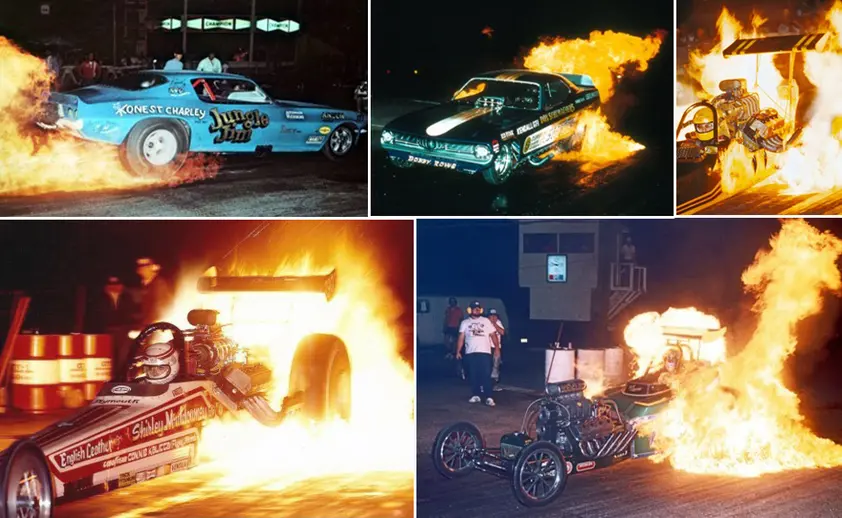
If the volume of email is any indicator, fire burnouts are still very much a hot topic among race fans of yore who witnessed the planned pyrotechnics on dragstrips across the nation.
Following up on my previous column about fire burnouts on magazine covers, Mike Lewis — who has done everything from managing dragstrips to helping run megateams to driving — shared with me one of the covers I couldn’t find last time, of his and brother Kent’s Sarge Arciero-driven Sparkling Burgundy in mid-burnout that ran on the cover of Cars magazine’s October 1972 issue and, of course, the story behind the story.
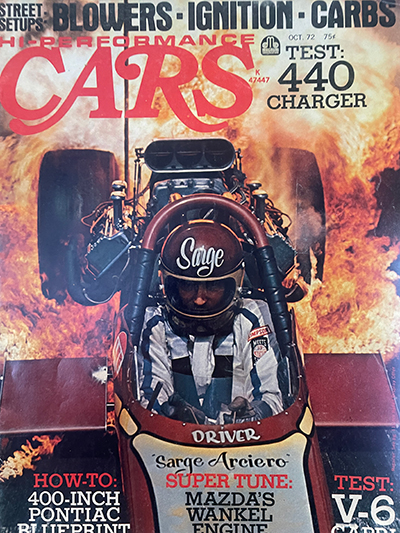
“It was Jim Cutler’s idea in 1972 to shoot the magazine cover,” Mike told me. “He fabricated a six-foot tripod that we mounted on the front of the chassis. He then mounted a motordrive camera on top of the tripod and operated it by remote control. It had to be sturdy enough for push starts. On our first attempt, we push-started the car on the track, and Sarge stopped the car in the shutdown area. We chose the shutdown area for safety during a weekly Maple Grove [Raceway] event. My brother Kent was ready with about two gallons of gas, but by the time Sarge rolled into the gas, most of it either dried up or seeped into the porous asphalt. The actual burnout was mostly tire smoke and not impressive.
“The cover photo was taken a few days later on the rubber-coated Maple Grove burnout area. We push-started Sarge in the direction of the starting line and turned the car around as if he were making a run. The plan was to straighten the car, check the camera, and roll the car back into the gas. I would then light the match and, with a very similar hand signal, motion Sarge to do the burnout. Kent emptied a five-gallon bucket of gas behind the car, and we just began to push Sarge back into the puddle when the headers ignited gas on the tires and the flaming puddle engulfed the back of the car. Jim triggered the motordrive. Sarge had a puzzled look for about six frames and then stood on the pedal. The shot on the magazine cover was just one of a dozen or more frames with the throttle blades wide open.
"The car came to a stop with the entire engine bay scorched. Every piece of chrome was blackened and two spark plug wires were burned through. Sarge was smiling when he unbuckled until we all saw the camera dangling upside down from the tripod. We feared that the whole shoot was in vain. Luckily, the camera came loose when Sarge stopped the car, and the result was a brilliant Jim Cutler magazine cover … and a lot of polishing to restore the Sparkling Burgundy shine.”

The previous column discussed the Lions fire burnout with the Kuhl & Olson Top Fueler and the overhead photo by Reyes that made the cover of Popular Hot Rodding magazine, but here’s the ground-level pic of the same inferno, as shot by Gary Densford and turned into a wonderful photo. Reader Gene Berry was kind enough to send the image to me from his collection. “I was one of those 10-year-old kids who sent my hard-earned soda bottle return money in for it. Plus, I also lived a couple of blocks from Lions [Dragstrip], which was great. I could set my Hot Wheel track up under the clothesline and start the cars when I heard them take off. Hot Wheels and sound effects didn't get much better than that!”
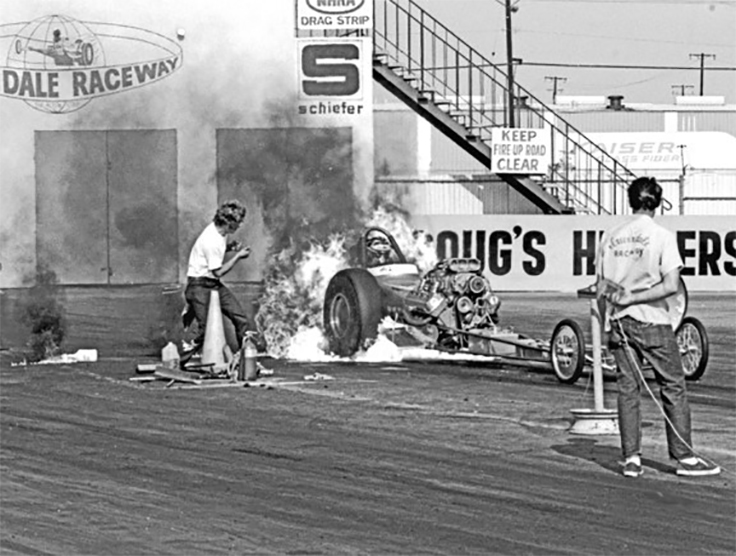
Steve Reyes, the king of fire-burnout photography, sent along another troubled fire burnout by Norm Reis and his front-engine Top Fuel dragster in Irwindale, Calif. “The crewman's pant leg is ablaze, and he's flinging a flaming bleach bottle, while Reis Norm is hitting the throttle as the bleach box is burning,” notes Reyes.
Reyes also shared the images below — “some of my favorite fire burnouts” — that weren’t all from him.
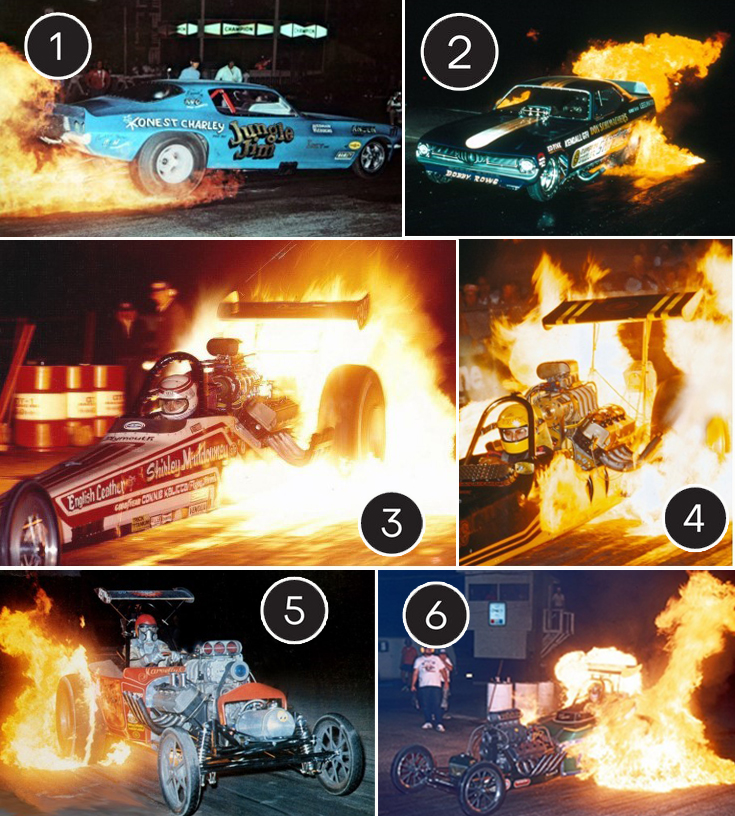
“The late Jeff Tinsley shared his ‘Jungle Jim’ [Liberman; photo 1] and Bobby Rowe [2] fire burnouts with me,” Reyes said. “ ‘Jungle' was the first Funny Car to do fire burnouts on the West Coast in 1971 with his Camaro Funny Car. Shirley’s fire burnout [3] was at Martin, Mich., and the story I heard is that when NHRA saw the centerspread in Popular Hot Rodding [magazine], they warned her not to do it again. That’s one of the few fire burnouts [4] that ‘the Greek’ [Chris Karamesines] did and the Winged Express doing its only fire burnout [5], Dave Hough in the Nanook [6] did them all the time, but he would forget to pull his goggles down and it looked funky with the goggles up."
“T.C. [Lemons] and [Don] Garlits did the best unplanned fire burnouts. ‘TV Tommy's' [Ivo] fire burnouts were nice but always planned, ‘Tarzan’ [John Austin] liked to try to burn up Ivo. ‘Jungle Jim’ did the best Funny Car fire burnouts with Bobby Rowe in Schumacher's blue Stardust Funny Car running a very close second. “
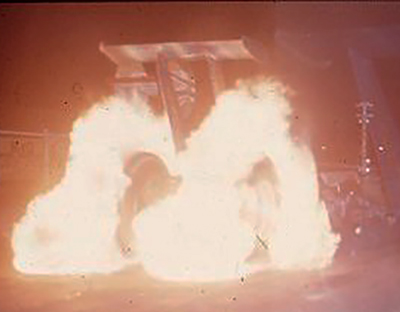
And speaking of Ivo, longtime reader and contributor Bill Warburton sent along the image above of Ivo in mid-fire burnout at Cecil County Dragway in 1973.
“Jimmy ‘Tuna’ Demarcella was a crewmember for ‘Jungle Jim’ Liberman in the late ‘60s and early ‘70s and told me how the 'Jungle Jim Funny Car Show ' perfected fire burnouts. Peter White, another crewman, perfected this part of their act. After trial and error, they came up with a blend of mixed fuels and solvents to give the right effect. Peter would wrap four matches in a strand of 'Jungle Pam's' hair, pour the mixture under the tires, light the matches, and sling the matches into the mixture, then give ‘JJ’ the sign to stand on it.
"He went on to travel with Tommy Ivo in ’73 and ‘74 ,and then with Garlits for a short while. ’Tuna’ told me that the track owners would have to pay around $100 extra if they wanted fire burnouts. He said that he would adjust the mixture of flammable liquid depending on whether it was at night or day. For daytime burnouts, they would change the mixture to be more visible in the daylight.
“Timing was always key to a great fire burnout: leaving too early before the flames developed would produce a poor burnout and stay too long in the fire you risked the chance of sucking up all the oxygen and stalling the motor, and then the driver gets a little toasted.”
As you can see, fire burnouts were sometimes a risky addition to the show, and it’s obvious why NHRA banned them decades ago, but it’s still fun to relive the magic.
Phil Burgess can be reached at pburgess@nhra.com
Hundreds of more articles like this can be found in the DRAGSTER INSIDER COLUMN ARCHIVE
Or try the Random Dragster Insider story generator



















































